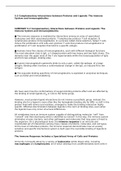Summary
Summary Chapter 5.2
- Course
- Biochemistry I (BIOL2080U)
Summary study book Lehninger Principles of Biochemistry of Nelson David L., Albert L. Lehninger, David L. Nelson, Michael M. Cox, University Michael M Cox (5.2) - ISBN: 9780716743392 (Chapter 5.2)
[Show more]



